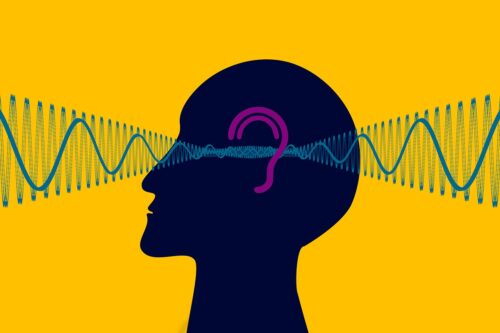Image courtesy of Pixabay.
Seven years before he finished translating the Bible, Martin Luther started hearing a loud buzz. The sound was so distracting that, whenever it started, he had to put his work aside and wait for the torment to go away. “The Devil had something to do with it,” he concluded in a letter.
Although this passage is almost five centuries old, the suffering it communicates still resonates with many today: an estimated fifty million Americans suffer from tinnitus, a highly heterogeneous disorder that manifests as phantom ringing in the ear. Although it can be ignored by some, five percent of those affected report severe impacts in their lives, ranging from concentration problems to difficulty socializing or even depression. Finding a solution to these problems can be challenging, as even identifying the source can be difficult.: For some, the sound can come from a physical source such as muscles in their ears, while for others, ringing originates from signal mismatches inside the brain. The former is rare and can sometimes be treated with surgery, while patients with the latter variety are left with the few and often ineffective treatments that are available. Cognitive behavioral therapy can help cope with the discomfort, but there are no approved interventions to reduce the intensity of the perceived sound.
A clinical trial published in Science Translational Medicine, however, is changing that landscape. And they are using a rather unexpected technique: a headphone that also shocks your tongue. The organ was chosen in part due to the high number of nerve endings on its surface. According to tinnitus specialist Berthold Langguth, who is chief physician at the Department of Psychiatry and Psychosomatic Medicine at Germany’s University of Regensburg Hospital, hearing and sensitivity in the tongue are actually very closely related. “You have very intense connections between the tongue and the trigeminal nerve, and the trigeminal nerve is strongly connected with the central auditory pathway,” Langguth said. By stimulating those overlapping senses, the team hoped to activate only the relevant parts of the brain and drive neuroplasticity— literally rewiring the brain to reduce symptoms.
This hypothesis has been in the works for some time, with promising studies in animals and smaller human cohorts. However, Langguth warns that early positive results may not translate into an effective treatment. “Frequently new treatments have very positive pilot studies [with] twenty or thirty patients. But then it is not possible to replicate these effects,” he said. This study, however, is different. Not only did they have over three hundred patients, but the impact of the treatment was overwhelmingly positive. “We don’t have a response in all patients, but the majority of patients who participated in the study reported relevant improvement that held for twelve months,” Langguth said.
The team also randomized patients in three groups to test which device configurations were most effective. The two main differences between the groups were the frequency of the sound and the length of delays—the amount of time between the sound being played and the stimulus on the tongue. Although delays improved outcomes in animals, humans showed better long-term improvement with synchronized activity. These observations allow future trials to have a better baseline for which to configure the device.
Those results also sketch a better future for the field of tinnitus research. “Twenty years ago there was very little tinnitus research. I think it’s the merit of philanthropic effort from non-profits […] and some patient organizations to help attract academic researchers to the field,” Langguth said. Now, public agencies have gained interest in the disorder, but the same cannot be said about the private sector yet. “There is not so much investment at the moment because there’s no success story,” he said. This clinical trial was funded by Neuromod, a private company for which Langguth serves on the Scientific Advisory Board, perhaps signaling changing tides for financing tinnitus treatment.
In spite of this development, Langguth stresses that prevention is still the best choice. “We have none, or only very few, well-established treatment options at the moment; however, what is very well established […] is that it’s possible to prevent tinnitus,” Langguth said. The condition is associated with hearing loss, but waiting for symptoms to appear is dangerous, as they might indicate that the damage is irreversible. Thus, early prevention methods as simple as avoiding loud noises and taking care of one’s hearing are crucial; after all, even though tinnitus care is improving, it is best to not need it.
References:
- American Tinnitus Organization. (n.d.). Understanding the Facts. American Tinnitus Association. Retrieved November 2, 2020, from https://www.ata.org/understanding-facts#nhnes
- Bikson, M., Brunoni, A. R., Charvet, L. E., Clark, V. P., Cohen, L. G., Deng, Z.-D., Dmochowski, J., Edwards, D. J., Frohlich, F., & Kappenman, E. S. (2018). Rigor and reproducibility in research with transcranial electrical stimulation: An NIMH-sponsored workshop. Brain Stimulation, 11(3), 465–480.
- Conlon, B., Langguth, B., Hamilton, C., Hughes, S., Meade, E., Connor, C. O., Schecklmann, M., Hall, D. A., Vanneste, S., & Leong, S. L. (2020). Bimodal neuromodulation combining sound and tongue stimulation reduces tinnitus symptoms in a large randomized clinical study. Science Translational Medicine, 12(564).
- Langguth, B., Kreuzer, P. M., Kleinjung, T., & De Ridder, D. (2013). Tinnitus: Causes and clinical management. The Lancet Neurology, 12(9), 920–930.
- Morgenstern, L. (2005). The bells are ringing: Tinnitus in their own words. Perspectives in Biology and Medicine, 48(3), 396–407.;

